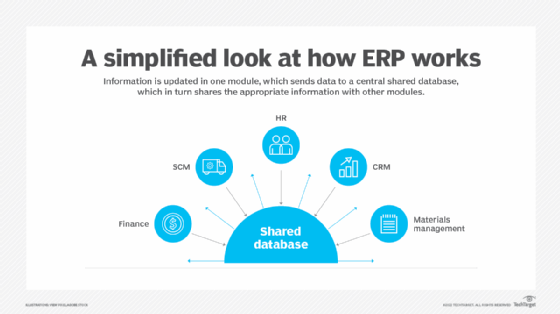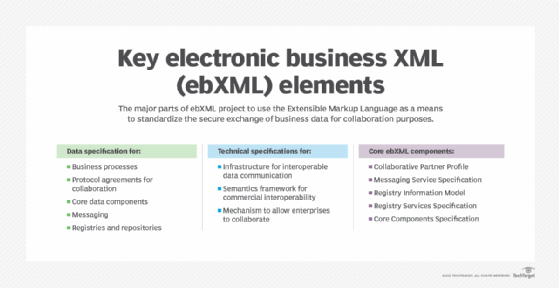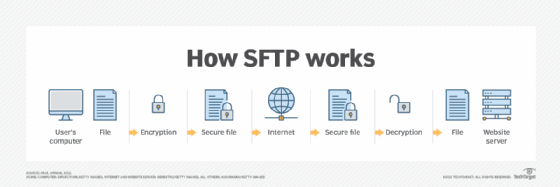Electronic Data Interchange (EDI)
What is Electronic Data Interchange (EDI)?
Electronic Data Interchange (EDI) is the transfer of data from one computer system to another by standardized message formatting without the need for human intervention. The goal of EDI is to replace manual processes that involve the exchange of documents with a fully autonomous one. EDI permits multiple companies -- possibly in different countries -- to exchange documents electronically. Most exchanges rely on the internet for connectivity between companies, though data can also be exchanged through serial links and peer-to-peer networks.
It can be used for documents such as purchase orders, invoices, shipping notices and commission sales reports, as well as other important or sensitive information. For example, an insurance company can verify that an applicant has a driver's license through EDI.
EDI goes beyond simply sending documents, such as PDFs and Word files, through an email or file transfer. In a proper EDI implementation, these requests are not processed by a human at all. They are automatically ingested into the business system, such as an enterprise resource planning (ERP) platform, and replies are automatically sent.
An EDI message contains a string of data elements, each of which represents a singular fact, such as a price, product model number and so forth, separated by a delimiter. The entire string is called a data segment. One or more data segments framed by a header and trailer form a transaction set, which is the EDI unit of transmission -- equivalent to a message. A transaction set often consists of what is usually contained in a typical business document or form.
When sending an EDI document, both parties, or trading partners, must adhere to the same set of rules. These standards define where and how the information from the document is found.

How Electronic Data Interchange works
Most EDI implementations use translator software to interpret the EDI messages and integrate it with the in-house software. Translation software processes the information differently for sent and received messages and performs a complete audit of each step to ensure information is sent or received in EDI format. For example, when the translator on the receiving computer reads a document, it knows where to find the buyer's company name, order number, purchase items and price. This information is then sent to the receiver's order entry system without necessitating manual order entry.
EDI is primarily used by large companies to have a uniform processing system, enabling efficiency. Cost, speed, accuracy and efficiency are the major benefits of EDI. The system is expensive to implement and usually requires help from a consultant that specializes in the field.
EDI competes with application programming interfaces (APIs) -- code that enables two software programs to communicate directly. While similar to EDI, APIs lack a standard for users, making it hard for different businesses to share information via APIs. APIs for business use also require that the companies already trust each other and that they have put in work to integrate. So, for example, a company most likely wouldn't use an API for a single purchase order but may be willing to submit a purchase order through a standard EDI system.
Using EDI systems eliminates the need -- and, therefore, cost -- to print, file, store, post and retrieve paper documents. The goal is to get rid of paper and have everyone working with the same invoice so that information is processed and read easily. It also reduces the likelihood of human error while processing documents.
Automating paper-based tasks improves data quality, and transactions are exchanged within seconds or minutes instead of days or weeks. EDI frees up staff time to work on more important tasks. Business-critical data is sent on time and tracked in real time by automating the transfer of data among applications across a supply chain.
Some users, such as doctors transmitting healthcare information, may find EDI more burdensome than antiquated systems, like paper or faxes, but the standardization and electronic conversion pay dividends in the long run.
Different EDI standards address the needs of industries, regions or other specifications. American National Standards Institute (ANSI) Accredited Standards Committee (ASC) X12 is routinely used in the U.S., and Electronic Data Interchange for Administration, Commerce and Transport, or EDIFACT, is used outside of the U.S. Also, numerous other standards relate to specific industries, such as VDA for the German automotive industry.
The Data Interchange Standards Association, an organization that developed and proliferated the standards for interchanging electronic business across multiple industries, supported ASC X12. Three times a year, X12 members work together across various industry verticals, such as finance and healthcare, to develop new versions of the standard.
Types of EDI systems
Different types of EDI are implemented to suit the business's needs, capabilities and budget -- assisting multiple consistent business partners, supporting partners around the globe or aiding in other situations.
Most EDI implementations use a mailbox-style interchange. Messages are sent to the receiver, where they are then batch processed. The following are some of the types of EDI transmission:
- Direct EDI. With direct EDI, one connection is created between two business partners. Larger businesses might choose this method if they have numerous transactions with the same partner per day.
- EDI via value-added network or EDI network services provider. A third-party service runs a network that many companies are members of. This model protects businesses from the complications that come from supporting the many communication protocols that are required when dealing with multiple business partners. It is a secure network where documents are transmitted between business partners.
- Electronic Business Extensible Markup Language. EbXML is a standard way to exchange business data using XML. It can replace traditional EDI systems or carry EDI messages.
![key electronic business xml (ebXML) elements diagram]()
These are the major parts of the ebXML project to use XML as a means to standardize the secure exchange of business data for collaboration purposes. - EDI via Applicability Statement 2 (AS2). This communications protocol securely exchanges data over the internet. Two computers -- a client and a server -- connect in a point-to-point mode through the internet. AS2 creates an envelope for secure delivery that uses digital certificates and encryption.
- EDI via FTP/VPN, SFTP, FTPS. File Transfer Protocol with virtual private network, Secure FTP or FTP Secure exchange documents through the internet, connecting business partners directly. These protocols encode data during transmission from one business to the other to protect sensitive information. Data is decrypted upon arrival.
![how SFTP works diagram]()
SFTP enables critical files and sensitive data to be transferred over a network. - Web EDI. EDI is directed via internet browser, duplicating paper-based documents into web forms that contain fields where users enter information. It is then automatically converted into an EDI message and sent via secure internet protocols.
- Mobile EDI. This method enables the transmission of documents through mobile devices.
- Managed services EDI. Managed services systems outsource the EDI document control to a third-party provider.
Business needs and processes determine which EDI system to implement. Before moving to EDI in your organization, establish a managerial structure. Members of the team should have EDI and executive experience. Next, set priorities for adoption, and then analyze which areas of the business will benefit most from EDI. Select an EDI network provider that focuses on your business necessities. Then, assimilate EDI and data into the business.
To outline how the data in the EDI transaction correlates to the data in the internal system, create a map that determines where each incoming field goes and if the data needs to be reformatted. Test the system before implementing it live.
Example Electronic Data Interchange
EDI is plaintext that is transmitted between parties. It uses standard code numbers to define the type of document and text elements to define what each section of text represents. Most transactions require the parties to exchange several messages to complete the transaction. For example, the buyer might send an EDI message code 850 for a purchase order, and the seller might respond with an 855 code for a purchase order acknowledgment.
An example purchase order using ANSI:
ST*850*0001~BEG*00*RL*27497*1001*20240412**NA*IEL~N1*BY*TechTarget*9*123456789-0101~N3* 275 GROVE STREET~N4* NEWTON*MA*02466~PO1*1*40*EA*5*PE*MG*G5004~IT8 *******B0~CTT*1~AMT*TT*200~SE*10*0001~
The ~ is the delimiter between the data elements. The first few characters of the data element tell the system what that element represents. Asterisks separate the fields within the data element.
The above submits a purchase order number 27497 dated April 12, 2024, by TechTarget at 275 Grove St, Newton, MA, 02466, which wants to buy one item number G5004 at a quantity of 40 at $5 each for a total cost of $200.
See a full example here and here.
EDI applies to many different business aspects. Learn ways EDI has streamlined supply chain management.









